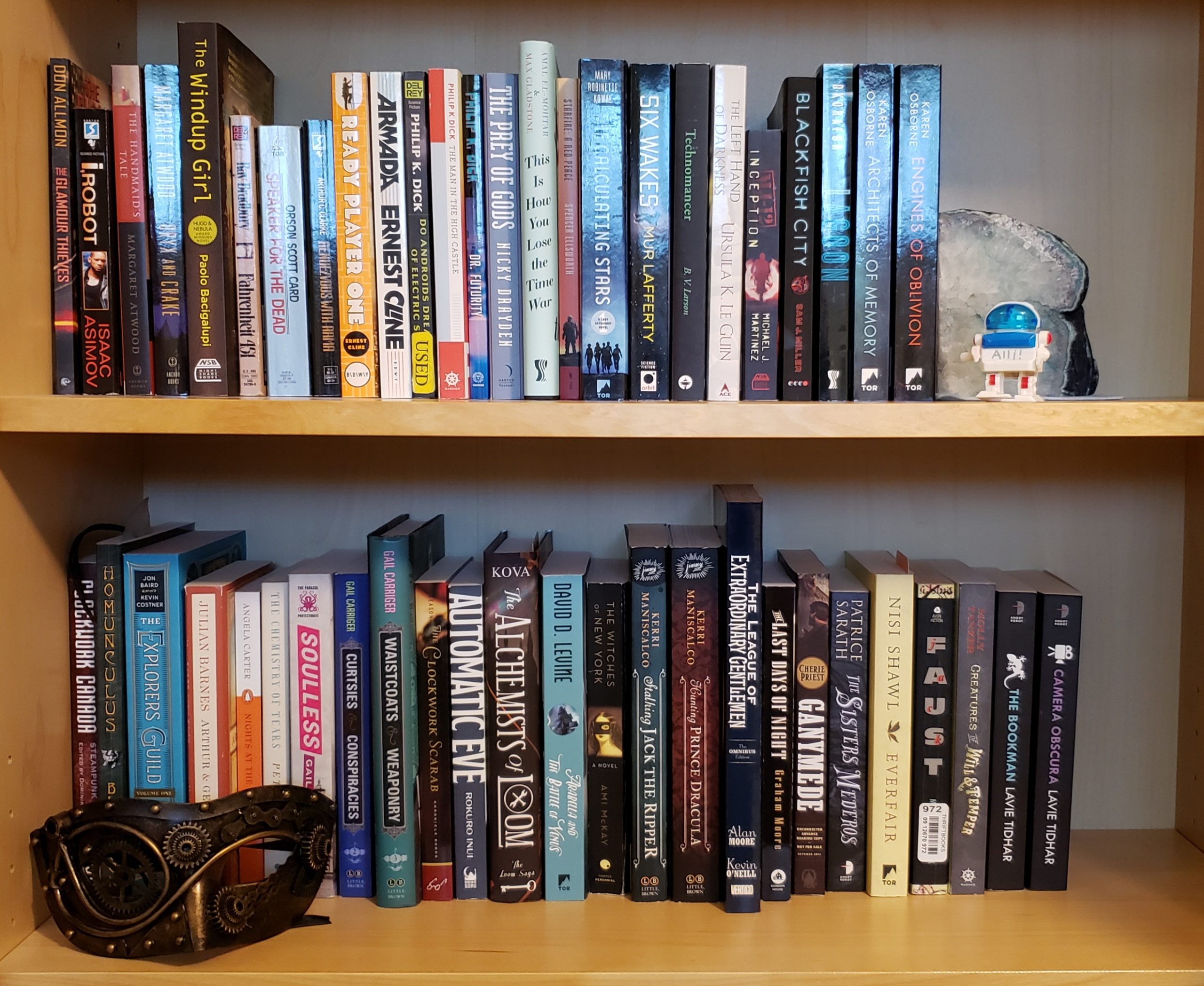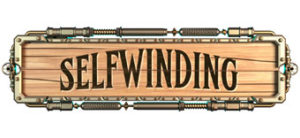In 2008 one of my friends introduced me to the term “steampunk.” I’d say that I fell in love then, except I’d apparently been a fan of this genre without having known it existed. That’s the thing about punk sub-genres, they’re still not well known and even if you know about them, there are so many—and so many new ones—that they can easily be confused by even the most knowledgeable.
With how many punk subgenres there are, figuring out in which one a story “belongs” can be a tricky thing. For me, punk genres are defined by three things:
- the time period and aesthetics
- the technology
- the punk social element
There are other elements that identify specific genres (steampunk is often optimistic whereas cyberpunk is often cynical), but these three earmarks are apparent in most punk subgenres, which is why I find them so helpful for classification.
I’m limiting my exploration to eight punk subgenres that are relevant either as to their popularity or for illustrating examples of identification. This is by no means a complete list of punk subgenres, and will probably be an outdated list within a year, so take this as an introductory guide to figuring out how to break down punk subgenres into their elements.
The Time Period & Aesthetics
The time period defines many of the other elements, so it is one of the most definitive indicators of a punk subgenre. Even stories set in the future or in a completely fictional universe on a different planet are inspired or influenced by these time periods. Identifying the historical influence can help narrow down the genre since there are very few overlaps in those aesthetics.
Clockpunk 1300–1550
Steampunk 1830–1900
Dieselpunk 1910–1945
Decopunk 1920–1950
Atompunk 1945–1965
Cyberpunk 1980–future
Biopunk 1990–future
Solarpunk 2000–future
For alternate histories, these dates aren’t hard starts and stops. One thing to consider is what those years have in common and if it makes sense to include a story outside of that range. For example, steampunk is largely defined by the Victorian Era, which corresponds with the reign of Queen Victoria (1837–1901). I’ve seen stories listed as steampunk (and that I recognize as being steampunk) taking place as late as 1910. But they worked as steampunk stories because they highlighted other story elements recognizable as steampunk (which I’ll get into below).
In addition to the time period, stories have to take into account cultural aesthetics. As mentioned, Victorian England has greatly influenced steampunk as a genre, but there is also steampunk based on American and non-Western settings. These stories take aesthetic notes from the locations and cultures in which they are set. While bustles and four-in-hand ties can be indicators of steampunk, so can spurs and boots and kimonos. It all depends on which time period and cultural notes are used for inspiration.
The Technology
The technology is partly dependent on the time period. Even though many punk genres have a science fiction element that pushes the technology beyond what was possible within that time period, it still has a historical (or contemporary) basis. For many punk subgenres, the technology is in the title.
Clockpunk — clockwork technology, no engines (lots of clicking)
Steampunk — steam technology, including trains and steam engines
Dieselpunk — diesel-based technology, like combustion engines
Decopunk — technologies appropriate to the time period 1920–1950
Atompunk — nuclear technology, most especially the atom bomb
Cyberpunk — cyber technology, internet, wired or wireless, virtual reality
Biopunk — merging technology with biology, electronic or digital prosthetics
Solarpunk — renewable energies, specifically solar powered
The only genre in the above list that doesn’t have a nod to the technology in the title is decopunk. The name “decopunk” refers to the aesthetics of the genre. To me, that means the aesthetics are as important to decopunk as steam is to steampunk or biotechnology is to biopunk. It also forces us to reconsider what we mean when we say “technology.” Is technology just weapons and vehicles, or does it include the ability to mass-produce clothing and furniture? Does it include the timesaving home technologies that allow people the freedom to visit a speakeasy? Does it include the ability for a detective to analyze fingerprints? The point being: there’s a lot of technology that isn’t easily summarized in one word, and decopunk is a good example of how that technology might appear in a punk subgenre.
An important note on the technologies: there is always an overlap in time periods because technology is always moving forward (and a story with strong science fiction elements may be leaning into that progress). Reality functions in much the same way. For example, the atom bomb was being developed during prime years covered by the dieselpunk time frame. In that case, to figure out if a story is dieselpunk or atompunk, the social concerns and aesthetics need to be considered. Would you classify a story set in 1938 about the construction of the atom bomb as dieselpunk or atompunk? What’s the primary technology being discussed/used?
The Social Element
The counterculture element is the core of a punk story. Social concerns and a reaction against certain culture movements are, after all, what makes a story punk. Any of the isms can be a focal social concern: racism, sexism, and classism are common topics in steampunk. Individuality is a common topic in cyberpunk. Atompunk focuses around concerns of nuclear war and nuclear energy, whereas solarpunk tends to take on environmental concerns and renewable energy. Most of the social concerns grow out of the time period that influences the genre.
Some potential (but not all) social concerns for the genres:
Clockpunk — religious influence, exploration & trade, diversified division of labor
Steampunk — colonialism, sexism, racism, classism, factory work/unions
Dieselpunk — nationalism, world war, factory work/unions, women’s suffrage
Decopunk — decadence, apathy
Atompunk — atomic energy, nuclear war/winter, space flight, civil rights
Cyberpunk — individuality, autonomy, humanism, transhumanism
Biopunk — humanism, transhumanism, body modification
Solarpunk — environmental issues, renewable energy
For genres in which the time periods overlap, the social elements are often the defining traits of the genre. Decopunk and dieselpunk cover nearly the same time period and would ultimately use the same technology, however a decopunk story will be more urban, upper class, and decadent. The social concerns will likely include a reaction against decadence and apathy. In dieselpunk, characters will interact more personally with gasping combustion engines and the thrust and grime of mechanics, expressing opinions on nationalism and world wars or the advent of the assembly line.
Some social concerns are shared across genres, so the key to identifying the genre may lie in identifying how that social concern is being addressed. A transhumanism issue in cyberpunk is likely to include how the mind connects with a computer or virtual reality, whereas in biopunk the concern is grounded in modifying a physical body and exploring the question of what defines a body as “human.” Identifying the genre by the social element requires depth of knowledge about the genres and the subject of the story.
A Grain of Salt
While these are earmarks I find particularly helpful for identifying genres, there is a caveat here in that genre definitions can change as genres age and become defined by the works rather than the works being defined by the genre. Early steampunk work and some recently marketed novels don’t gel with the definitions I outlined above, so in general I recommend keeping your definition in mind for your own work and for your bookshelf, but not fussing too much if someone’s classification doesn’t entirely align with your own. Genres are used primarily for marketing, which means whenever a genre is hot, the definition for what fits in that genre widens considerably.
 Genres exist primarily as organizational and marketing tools and are one way for readers to find stories they’ll like and for stories to find an audience. (If you like this story about a robot, here’s where to find more stories about robots.) If the main task of a sci-fi story is to ensure the sci-fi element is integral to the plot, I wouldn’t call that a constraint, but it is a necessary element of the story.
Genres exist primarily as organizational and marketing tools and are one way for readers to find stories they’ll like and for stories to find an audience. (If you like this story about a robot, here’s where to find more stories about robots.) If the main task of a sci-fi story is to ensure the sci-fi element is integral to the plot, I wouldn’t call that a constraint, but it is a necessary element of the story.